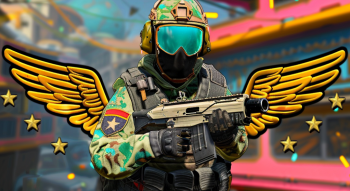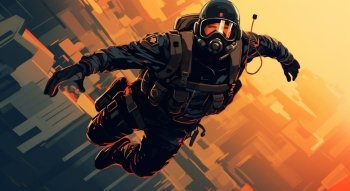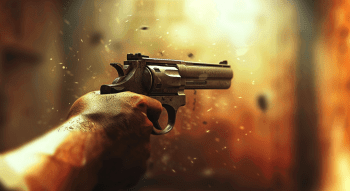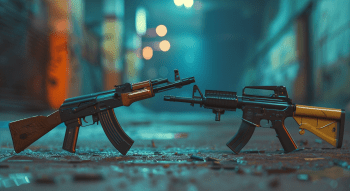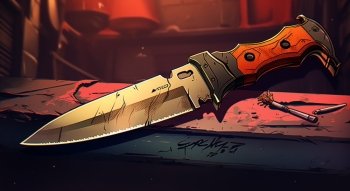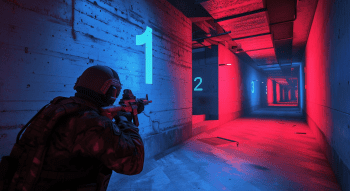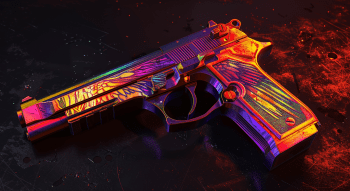All About CS2 Skin Conditions
Contents

Skins have been a very special part of the Counter-Strike franchise since their introduction in 2013. Unsurprisingly, CSGO skin conditions were one of the most discussed topics for that version of the game.
And before you ask, yes, CS2 skin conditions are no different. With a constantly growing market (currently valued at $2 billion+), the game shows no signs of losing popularity, which means the skins will also retain their sometimes ludicrous monetary value. In this article, we’ll break down everything you need to know about skin floats, patterns, finishes, and everything else you need to know before entering the CS2 market. Whether you’re a newcomer or an old lion, you’ll surely find something useful here. Let’s go!
What Are Basic CS2 Skin Conditions?
Every CS2 skin is a unique virtual consumable, possessing an unrepeatable set of parameters that are inherent to its creation. Every in-game item was once unpacked/unboxed, crafted, or dropped as the weekly reward. Here’s a short list of CS2 skin conditions and parameters:
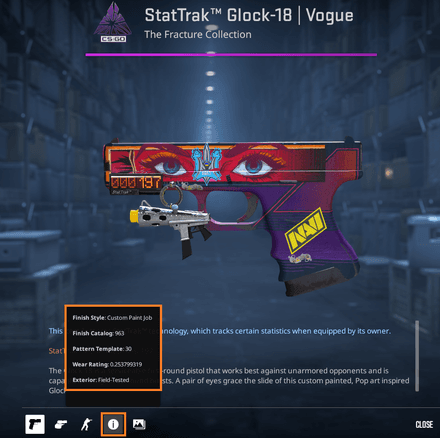
Finish Style
Finish style typically refers to the design of the skin. Currently, there are nine types: Solid Color, Spray-Paint, Hydrographic Style, Anodized, Anodized Multicolored, Anodized Airbrushed, Patina, Custom Paint Job, and Gunsmith. The majority of modern skins are Custom Paint Job or Gunsmith.
Finish Catalog
A specific number that starts from 1 and can well exceed 1,000. It’s typically used to group skins by their family (like Printstream, Crimson Web, which are available for several different guns), but that’s not always the case.
Pattern Template
All skins have a pattern (from 0 to 1000), but it only becomes important for certain skin families. For example, CS2 Case Hardened patterns became legendary because of their incredibly rare Blue Gem versions, while Slaughters are also separated into several types based on the visible lines on the gun. Still, those are the exceptions, and the overwhelming majority of CS skins look virtually the same regardless of the pattern.
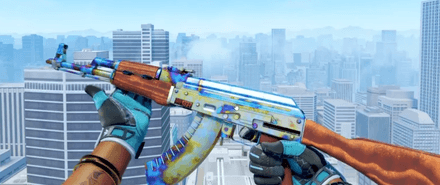
AK-47 | Case Hardened (Blue Gem)
Wear Rating
This number determines the appearance of a skin, and ranges from 0 to 1, with up to 16 digits after the decimal point (some sites display only the first seven; in the game, you can see nine).
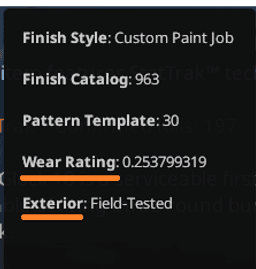
Exterior
This is a fast grouping of the Wear Rating code for easier understanding of how good the skin looks. There are five Wear Stages: Factory New, Minimal Wear, Field-Tested, Well-Worn, and Battle-Scarred. Most skins are available in all five of CS2 conditions, but certain rare specimens are limited to just FN or MW.
Misconduct With Doppler & Gamma Doppler Skins
Even experienced Counter-Strike players tend to confuse Doppler and Gamma Doppler finishes with other CS2 skins conditions. So, here’s a quick reminder: all the phases and names the skins have (Ruby, Black Pearl, Sapphire, Emerald) have nothing to do with wear and refer to specific visual features of the knives. Needless to say, CS2 Doppler skin patterns heavily impact the pricing of this skin family.
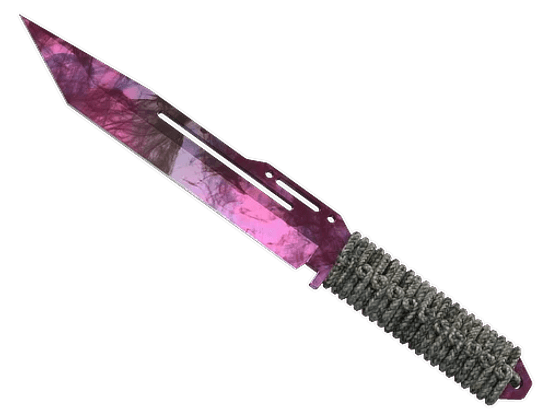
Types of Skin Conditions in CS2
A skin’s quality, or float value, ranges from the pristine Factory New to the worn-off Battle-Scarred. Float determines a skin’s appearance and, hence, its price. All the best CS2 marketplaces use a Valve-based system with 5 CSGO weapon conditions (it remains the same in CS2):
Factory New
The highest quality with minimal wear, which usually means the most vibrant and clear looks money can buy. FNs are typically the most sought-after and expensive variants of the skin.
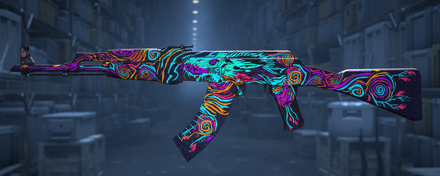
Minimal Wear
The weapon shows slight wear but remains in excellent condition, making it slightly more affordable than its Factory New counterpart.
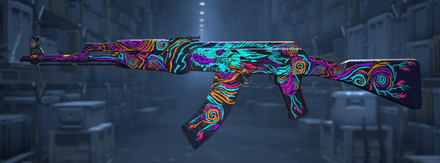
Field-Tested
These skins display moderate wear, such as scratches and fading, but are far more affordable, catering to those who want to look good without breaking the bank.
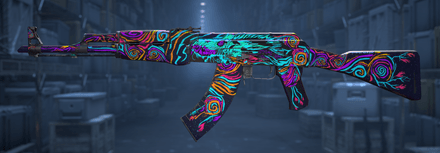
Well-Worn
These have noticeable wear and tear, making them more budget-friendly.
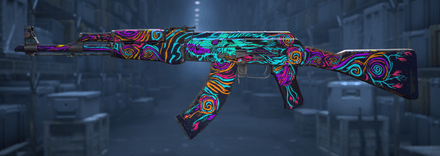
Battle-Scarred
The most worn condition with significant fading and scratches, usually available at the lowest prices.
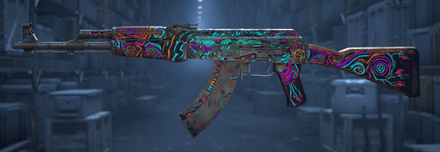
It is worth noting that the most expensive CS2 skins in Factory New condition can cost a literal fortune.
Understanding Float Value
Understanding float helps players trade smarter, avoid overpaying, and identify CS2 skins quality and value more easily.
What is Float in CS2 and Why Does it Matter?
Float is a decimal number ranging from 0.00 to 1.00 that defines a skin’s wear level. The basic rule is simple: the lower the float, the cleaner and more valuable the skin is.
Two skins of the same type can vary in value significantly based on their float. While lower floats are often more expensive, some rare or “battle-worn” skins retain value due to unique design or demand.
Float Ranges and Corresponding Exteriors
Here is a handy Wear Stages and Float Ranges table with some quick tips on their effect on skin pricing:
| Wear Stage | Float ranges | Description |
1. | Factory New (FN) | 0–0.07 | The best possible look of every skin with minimal wear, which naturally means the highest possible prices |
2. | Minimal Wear (MW) | 0.07–0.15 | A small number of scratches that rarely affect the skin all that much, but the cost can be much lower compared to FN |
3. | Field-Tested (FT) | 0.15–0.38 | The skin has some visible damage, but its nature and severity depend on the float number; you can expect moderate prices here |
4. | Well-Worn (WW) | 0.38–0.45 | Plenty of issues, including darker tones and fades; low price, and for a good reason |
5. | Battle-Scarred (BS) | 0.45–1.00 | Lots of visible damage; the lowest price on the market |
Ways to Check Float Value in CS2
Overall, there are four ways how to check float in CS2. You can assess a skin’s float:
- In-game via the Inspect option (Launch the game and use the “info” button below the skin);
- Through third-party sites (like csfloat or Buff163, they usually show info right below the skin or in its description);
- Using browser extensions (like Steam Inventory Helper, which will check non-closed Steam inventories right in the Browser tab).
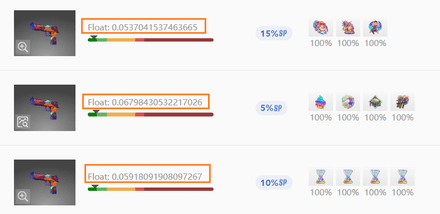
Buff163 gives Float as the basic info about the skin
How Skin Condition Affects Appearance
Although CSGO skin condition differences were already pretty easy to spot, the situation became even clearer in CS2. Overall, the effects of wear index fall into two broad categories:
Surface Damage
As float increases, visible damage appears on the majority of skins:
- Scratches, mostly around edges and metal parts;
- Paint loss on high-contact areas like the magazine or barrel;
- Rougher textures make the gun look older or more used.
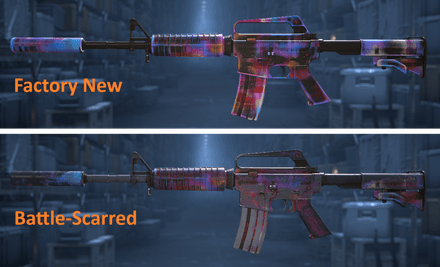
M4A1-S | Glitched Paint — apparent dye loss with float increase
Fading Colors and Blurred Designs
Higher-float skins also lose color brightness and texture sharpness:
- Designs become dull and less defined;
- Bright or metallic finishes turn matte or dirty-looking;
- Logos and fine details start to look washed out or faded.
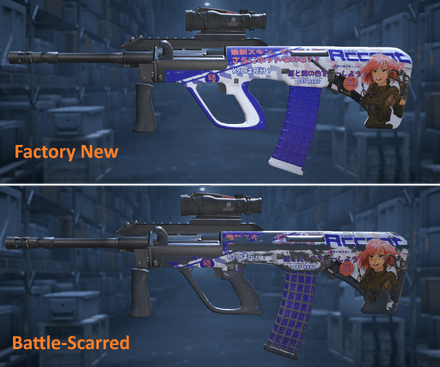
AUG | Akihabara Accept — a lot of details and inscriptions are washed out
Even two skins of the same type can look drastically different due to float alone.
Anomalies and Exceptions
Still, some skins work differently, and a lower float can mean more surface damage. For example, a monotonous color can become brighter, making the BS paint look even better than the FN one. That’s why we recommend always checking the skin before buying, as there’s a surprising number of exceptions from the generally accepted “lower float=good” rule.
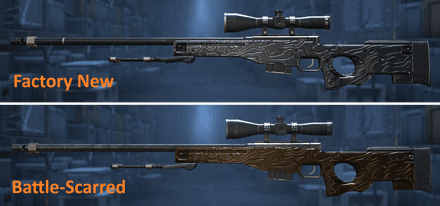
AWP | Black Nile — Battle-Scarred copy with bronze shades looks even more attractive
How Condition Impacts Market Value
Rarity Tiers
Skins in CS2 come in several rarity levels, which influence their value. The rarer the skin, the harder it is to get, and the more expensive it usually is. Let’s have CS2 skin rarity explained:
- Consumer Grade (White);
- Industrial Grade (Light Blue);
- Mil-Spec (Blue);
- Restricted (Purple);
- Classified (Pink);
- Covert (Red);
- Contraband (Red);
- Gold (Knives, Gloves).
The M4A4 | Howl is the only skin with Contraband status currently in the game. It was removed from active drops due to a copyright issue and is now worth thousands of dollars due to how rare it is.
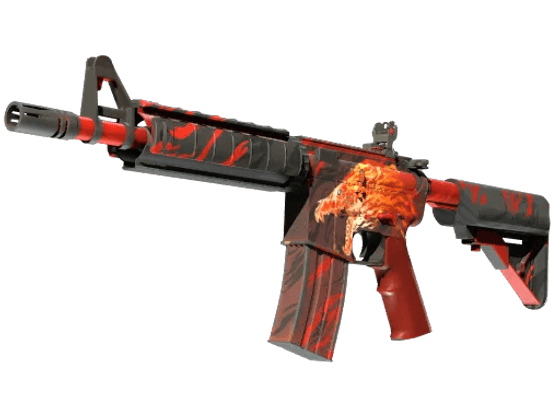
Condition (Float Value)
As we’ve explained above, each skin has a float value, with fresh-looking ones (those with smaller wear indexes) usually commanding the higher prices:
- Factory New (0 to 0.07) — most expensive, but looks great;
- Minimal Wear (0.07 to 0.15) — moderate price tag for good visual quality;
- Field-Tested (0.15 to 0.38) — balanced in terms of price and appearance;
- Well-Worn (0.38 to 0.45) — pretty cheap, but has a lot of visual damage;
- Battle-Scarred (0.45 to 1.0) — minimal cost for the worst appearance.
Special Features: Patterns and StatTrak
Some skins have unique patterns (e.g., Blue Gems on Case Hardened skins), making them highly desirable. Others may feature StatTrak, which counts your kills with that weapon. These additions boost the skin’s price significantly, regardless of its Float Value.
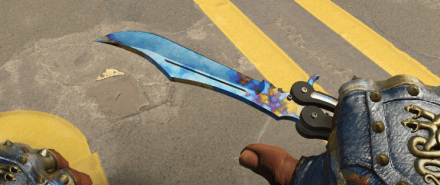
Butterfly Knife | Case Hardened (Blue Gem): Factory New, Pattern #838 — unknown price due to extreme rarity of having it, surely more than $10k
Esports Hype & Pro Player Influence
When a skin is used by a famous pro player or featured in a big tournament, its value can skyrocket. For instance, one of the game's GOATs, “s1mple”, used the AWP | Dragon Lore during a Major, making it one of the most famous and expensive skins in CS history.
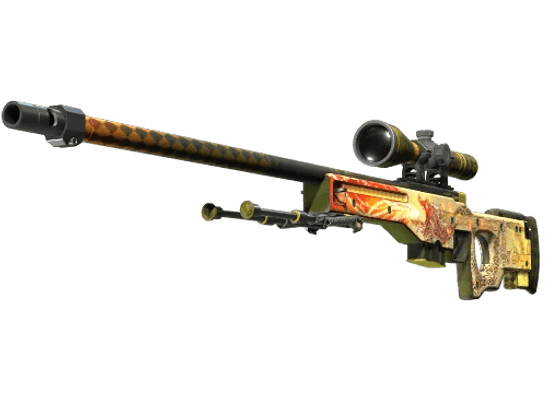
Souvenir Skins and Stickers
Souvenir skins drop during major esports events and include team/event-specific stickers. Their price depends on the event’s importance and the players involved. These skins have a unique backstory, making them collector’s items first and foremost. Additionally, older and rarer stickers located on the weapon can significantly increase its value, as some rarer ones (like those from the IEM Katowice 2014 collection) are worth tens of thousands of dollars.

How to Inspect Skin Condition Before Buying
Now that you know how to inspect skins in CS2, we recommend you pay attention to the following:
1. Check Float and Pattern
The float system is relatively straightforward and easy to use. If the skin in question has rare patterns, verify that the skin you review has the pattern number the seller claims it has.
2. Review the Skin at Third-party Websites
Although marketplaces and specific websites won’t provide an accurate representation of how the gun or knife will appear on your PC in the game (due to individual settings and hardware specifics), this is a quick way to conduct pre-screening. This way, you’ll be able to examine the skin’s overall look, its primary colors, defining features, and other details.

AWP | Exoskeleton, Field-tested, as it appears on the marketplace
3. Take a Look at the Skin Right in the Game
With so many parameters involved in defining the price and appearance of the weapon, the main rules remain the same even after a decade: CS:GO skin condition should always be checked in the game. Often, video settings can result in significant differences between how the skin appears on Steam or other Marketplaces and how it will look in-game.

AWP | Exoskeleton, Field-tested, in the game menu

AWP | Exoskeleton, Field-tested, on the map
***
CS2 gun conditions aren’t just cosmetic parameters — they directly affect how a weapon feels and how much it’s worth. Understanding float values, wear levels, and pattern rarity will help you make informed decisions when buying, selling, or trading skins. Whether you're collecting or just want the best-looking gun, having a good idea of what determines a skin’s value gives you a serious edge in CS2's massive and constantly growing economy.
